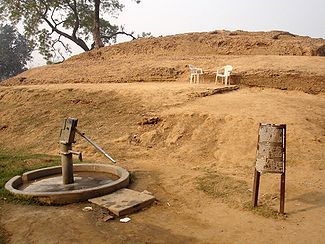
Pava
Encyclopedia

Pava was a city in ancient India
India
India , officially the Republic of India , is a country in South Asia. It is the seventh-largest country by geographical area, the second-most populous country with over 1.2 billion people, and the most populous democracy in the world...
, at the time of Gautama Buddha
Gautama Buddha
Siddhārtha Gautama was a spiritual teacher from the Indian subcontinent, on whose teachings Buddhism was founded. In most Buddhist traditions, he is regarded as the Supreme Buddha Siddhārtha Gautama (Sanskrit: सिद्धार्थ गौतम; Pali: Siddhattha Gotama) was a spiritual teacher from the Indian...
. It was a city of the Malla
Malla (India)
Malla was one of the solasa mahajanapadas of ancient India mentioned in the Anguttara Nikaya. It was named after the ruling clan of the same name. The Mahabharata mentions the territory as the Mallarashtra . The Malla mahajanapada was situated north of Magadha. It was a small mahajanapada...
s which the Buddha visited during his last journey, going there from Bhogagama and staying at Cunda
Cunda (Buddhism)
In Buddhism in the Mahaparinibbana Sutta Kunda was a blacksmith who gave the last meal of either mushrooms or pork to Buddha. The Buddha fell violently ill but told Cunda not to worry. Buddha recovered from his illness before he attained parinirvana....
's mango grove. Pava is located about 15 kilometres east of Kushinagar
Kushinagar
Kushinagar , Kusinagar or Kusinara is a town and a nagar panchayat in Kushinagar district in the Indian state of Uttar Pradesh. It is an important Buddhist pilgrimage site, where Gautama Buddha is believed to have attained Parinirvana after his death.-Demographics: India census, Kushinagar had a...
in Uttar Pradesh
Uttar Pradesh
Uttar Pradesh abbreviation U.P. , is a state located in the northern part of India. With a population of over 200 million people, it is India's most populous state, as well as the world's most populous sub-national entity...
, India
India
India , officially the Republic of India , is a country in South Asia. It is the seventh-largest country by geographical area, the second-most populous country with over 1.2 billion people, and the most populous democracy in the world...
.
Cunda lived in Pava and invited the Buddha to a meal, which proved to be his last. It was on this occasion that the Cunda Sutta was preached. From Pava the Buddha journeyed on to Kushinagar, crossing the Kakkuttha River on the way
According to the Sangiti Sutta, at the time the Buddha was staying at Pava, the Mallas had just completed their new Mote hall, Ubbhataka, and, at their invitation, the Buddha consecrated it by first occupying it and then preaching in it. After the Buddha had finished speaking, Sariputta recited the Sangiti Sutta
Digha Nikaya
The Digha Nikaya is a Buddhist scripture, the first of the five nikayas, or collections, in the Sutta Pitaka, which is one of the "three baskets" that compose the Pali Tipitaka of Theravada Buddhism...
to the assembled monks.
Pava was also a centre of Jainism
Jainism
Jainism is an Indian religion that prescribes a path of non-violence towards all living beings. Its philosophy and practice emphasize the necessity of self-effort to move the soul towards divine consciousness and liberation. Any soul that has conquered its own inner enemies and achieved the state...
and, at the time mentioned above, Mahavira
Mahavira
Mahāvīra is the name most commonly used to refer to the Indian sage Vardhamāna who established what are today considered to be the central tenets of Jainism. According to Jain tradition, he was the 24th and the last Tirthankara. In Tamil, he is referred to as Arukaṉ or Arukadevan...
had just died at Pava and his followers were divided by bitter wrangles. Cunda Samanuddesa was spending his rainy season
Chaturmas
Chaturmas is a holy period of four months , beginning on Shayani Ekadashi—the eleventh day of the first bright half, Shukla paksha, of Ashadh —until Prabodhini Ekadashi, the eleventh day of the first bright half of Kartik in Hinduism, Buddhism and Jainism.Chaturmas is reserved the...
at Pava, and he reported to the Buddha, who was at Samagama, news of the Nirgrantha
Nirgrantha
A Nirgrantha is a term that specifically refers to Jains in religious and philosophical works from the Indian religions. Mahavira , the most recent Jain tirthankara and a contemporary of Gautama Buddha, is referred to as the Nigaṇṭha Nātaputta in the Pāli Tipiṭaka.The Jain Agamas also contain...
s’ quarrels .
After the Buddha's death, the Mallas of Pava claimed a share in his relics. The Brahmin
Brahmin
Brahmin Brahman, Brahma and Brahmin.Brahman, Brahmin and Brahma have different meanings. Brahman refers to the Supreme Self...
Dona satisfied their claim, and a Stupa
Stupa
A stupa is a mound-like structure containing Buddhist relics, typically the remains of Buddha, used by Buddhists as a place of worship....
was erected in Pava over their share of the relics.

